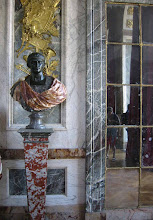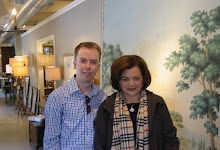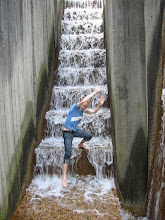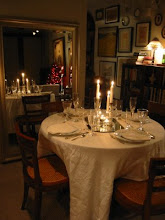
Much like it's neighbor, Versailles (which it is said to have had the first room dedicated entirely to private dining, setting the fashion), the Petit Trianon has a devoted dining room. The room is one of two with a crystal chandelier instead of the more typical lantern.

The dining room, seen here in blue, lies just above the
anteroom, the first room in the set of apartments.

One of the most famous stories about the PT is that the dining room had a mechanical dining table which rose out of the floor from the kitchen below. This way, dinner guests did not need to be waited on by servants and could eat in private. Unfortunately, the table was never completed but the foundation for the device was built and can still be seen in the basement.

The dining room is set on direct axis with the
French Pavilion, seen through the windows above. French houses always seem to have
the view as an important end goal: whether seen through an enfilade of rooms or at the end of an allee of trees. I think this is one of the reasons that the French style of architecture remains so popular: great views make for great spaces.

The dining room features some handsome dark wood chairs. Out of all of the rooms, the dining room felt the most masculine and the most strongly neoclassical, despite the red silk curtains!

A beautiful bust of Marie Antoinette rests above the fireplace in front of a large mirror. Directly across the room, between the french doors is an identical mirror. As meals would be eaten here by candelight, magnifying the light from the precious candles was of utmost importance. I suppose that is the practical reason for the crystal and the mirrors, but the glamour factor must have been part of the decision as well! To this day, dining rooms tend to be the most glamorous room in any house.

I just couldn't get over how beautiful all of the door hardware was and even the doors themselves so I'll end here with another great door shot! Also notice the beautiful Parquet de Versailles styled floors.
 Much like it's neighbor, Versailles (which it is said to have had the first room dedicated entirely to private dining, setting the fashion), the Petit Trianon has a devoted dining room. The room is one of two with a crystal chandelier instead of the more typical lantern.
Much like it's neighbor, Versailles (which it is said to have had the first room dedicated entirely to private dining, setting the fashion), the Petit Trianon has a devoted dining room. The room is one of two with a crystal chandelier instead of the more typical lantern. The dining room, seen here in blue, lies just above the anteroom, the first room in the set of apartments.
The dining room, seen here in blue, lies just above the anteroom, the first room in the set of apartments. One of the most famous stories about the PT is that the dining room had a mechanical dining table which rose out of the floor from the kitchen below. This way, dinner guests did not need to be waited on by servants and could eat in private. Unfortunately, the table was never completed but the foundation for the device was built and can still be seen in the basement.
One of the most famous stories about the PT is that the dining room had a mechanical dining table which rose out of the floor from the kitchen below. This way, dinner guests did not need to be waited on by servants and could eat in private. Unfortunately, the table was never completed but the foundation for the device was built and can still be seen in the basement. The dining room is set on direct axis with the French Pavilion, seen through the windows above. French houses always seem to have the view as an important end goal: whether seen through an enfilade of rooms or at the end of an allee of trees. I think this is one of the reasons that the French style of architecture remains so popular: great views make for great spaces.
The dining room is set on direct axis with the French Pavilion, seen through the windows above. French houses always seem to have the view as an important end goal: whether seen through an enfilade of rooms or at the end of an allee of trees. I think this is one of the reasons that the French style of architecture remains so popular: great views make for great spaces. The dining room features some handsome dark wood chairs. Out of all of the rooms, the dining room felt the most masculine and the most strongly neoclassical, despite the red silk curtains!
The dining room features some handsome dark wood chairs. Out of all of the rooms, the dining room felt the most masculine and the most strongly neoclassical, despite the red silk curtains! A beautiful bust of Marie Antoinette rests above the fireplace in front of a large mirror. Directly across the room, between the french doors is an identical mirror. As meals would be eaten here by candelight, magnifying the light from the precious candles was of utmost importance. I suppose that is the practical reason for the crystal and the mirrors, but the glamour factor must have been part of the decision as well! To this day, dining rooms tend to be the most glamorous room in any house.
A beautiful bust of Marie Antoinette rests above the fireplace in front of a large mirror. Directly across the room, between the french doors is an identical mirror. As meals would be eaten here by candelight, magnifying the light from the precious candles was of utmost importance. I suppose that is the practical reason for the crystal and the mirrors, but the glamour factor must have been part of the decision as well! To this day, dining rooms tend to be the most glamorous room in any house.
 This past weekend I had a few friends over for dinner and they were nice enough to let me interrupt the party to photograph the table settings for the weekly
This past weekend I had a few friends over for dinner and they were nice enough to let me interrupt the party to photograph the table settings for the weekly 


 Here is what we had (ignore the lamp cord!) - roast beef with carrots, potatoes and celery -a hearty winter meal on a snowy day.
Here is what we had (ignore the lamp cord!) - roast beef with carrots, potatoes and celery -a hearty winter meal on a snowy day.  For dessert (lemon pound cake with fresh whipped cream) I used the bread plates for Wedgwood 'Cuckoo', the small coffee service is antique Austrian by Ernst Wahliss, the teacups are antique Minton and the sugarbowl is cobalt jasperware by Wedgwood.
For dessert (lemon pound cake with fresh whipped cream) I used the bread plates for Wedgwood 'Cuckoo', the small coffee service is antique Austrian by Ernst Wahliss, the teacups are antique Minton and the sugarbowl is cobalt jasperware by Wedgwood.
 The tea (violet from Laduree) was served on my sideboard from my wedgwood 'cuckoo' teapot. The sterling tea strainer was NOT fun to polish after a few years of not being used! Crystal candlesticks I brought back from my trip to Paris in the fall.
The tea (violet from Laduree) was served on my sideboard from my wedgwood 'cuckoo' teapot. The sterling tea strainer was NOT fun to polish after a few years of not being used! Crystal candlesticks I brought back from my trip to Paris in the fall.
 The evening had some ups and downs -the foil from the champagne gave me a nasty cut which would NOT stop bleeding! The rest of the rose was the best medicine......
The evening had some ups and downs -the foil from the champagne gave me a nasty cut which would NOT stop bleeding! The rest of the rose was the best medicine......
 I hope you enjoyed the meal as much as we did!
I hope you enjoyed the meal as much as we did! 




 The room has 2 beautiful white marble busts on columns flanking the window with the garden view, but unfortuantely I can't remember who they are!
The room has 2 beautiful white marble busts on columns flanking the window with the garden view, but unfortuantely I can't remember who they are! The doors leading into the dining room have a more ornate boiserie and again, beautiful gilded bronze hardware. Imagine carving all of this by hand!
The doors leading into the dining room have a more ornate boiserie and again, beautiful gilded bronze hardware. Imagine carving all of this by hand!





















.jpg)





















.JPG)






































































